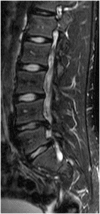Apophyseal ring fracture associated with two levels extruded disc herniation: case report and review of the literature
- PMID: 25003931
- PMCID: PMC4891168
- DOI: 10.1590/s1679-45082014rc2736
Apophyseal ring fracture associated with two levels extruded disc herniation: case report and review of the literature
Abstract
Apophyseal ring fractures are rare injuries that may be associated with lumbar disc herniation in young patients. We report a unique case in the literature of a 15-year-old male patient who played football and was admitted at our service complaining of sciatica radiating into the left leg. An apophysial ring injury of L5 vertebral body was observed. This injury caused two extruded disc herniation in adjacent levels. Surgical procedure was indicated after failure of conservative treatment.
As fraturas do anel apofisário são lesões raras, que podem estar associadas à hérnia de disco lombar nos pacientes jovens. Apresentamos aqui um caso único na literatura de paciente de 15 anos, gênero masculino, praticante de futebol, com queixa de ciatalgia para o membro inferior esquerdo. Houve lesão do anel apofisário, nos planaltos superior e inferior do corpo vertebral de L5, ocasionando hérnias discais extrusas nos níveis adjacentes. O procedimento cirúrgico foi indicado após a falha do tratamento conservador.
Figures




Similar articles
-
Fractures of the posterior apophyseal ring of the lumbar vertebral body in young patients. Three cases.Chir Organi Mov. 1990 Apr-Jun;75(2):129-33. Chir Organi Mov. 1990. PMID: 2279416 English, Italian.
-
Posterior ring apophysis separation combined with lumbar disc herniation in adults: a 10-year experience in the surgical management of 87 cases.J Neurosurg Spine. 2011 Apr;14(4):475-83. doi: 10.3171/2010.11.SPINE10392. Epub 2011 Feb 4. J Neurosurg Spine. 2011. PMID: 21294611
-
Fracture of the lumbar vertebral ring apophysis imitating disc herniation.Acta Neurochir (Wien). 1991;113(1-2):52-6. doi: 10.1007/BF01402115. Acta Neurochir (Wien). 1991. PMID: 1799144
-
[Lumbar disc herniation].Chir Narzadow Ruchu Ortop Pol. 2007 Mar-Apr;72(2):95-7. Chir Narzadow Ruchu Ortop Pol. 2007. PMID: 17633749 Review. Polish.
-
Intraradicular extruded disc herniation as a rare cause of failed back surgery - case report and review of the literature.Neurol Neurochir Pol. 2008 May-Jun;42(3):251-4; discussion 254. Neurol Neurochir Pol. 2008. PMID: 18651331 Review.
Cited by
-
Posterior Ring Apophyseal Fracture (PRAF) in a 13-Year-Old Adolescent Girl Treated With Unilateral Biportal Endoscopy: A Case Report.Cureus. 2024 Sep 13;16(9):e69351. doi: 10.7759/cureus.69351. eCollection 2024 Sep. Cureus. 2024. PMID: 39411634 Free PMC article.
-
Cauda Equina Syndrome in a Patient with Intradural Schwannoma at the Same Level as an Acute L2 Compression Fracture.Cureus. 2019 Aug 26;11(8):e5492. doi: 10.7759/cureus.5492. Cureus. 2019. PMID: 31656717 Free PMC article.
-
Radiological Diagnosis of Chronic Back Pain.Oman Med J. 2022 May 31;37(3):e385. doi: 10.5001/omj.2021.79. eCollection 2022 May. Oman Med J. 2022. PMID: 35651500 Free PMC article. No abstract available.
-
Traumatic lumbar vertebral ring apophysis fracture with disk herniation in an adolescent.Radiol Case Rep. 2017 Feb 4;12(2):427-430. doi: 10.1016/j.radcr.2016.11.026. eCollection 2017 Jun. Radiol Case Rep. 2017. PMID: 28491203 Free PMC article.
References
-
- Kurihara A, Kataoka O. Lumbar disc herniation in children and adolescents. A review of 70 operated cases and their minimum 5-year follow-up studies. Spine (Phila Pa 1976) 1980;5(5):443–451. - PubMed
-
- Lowrey JJ. Dislocated lumbar vertebral epiphysis in adolescent children. Report of three cases. J Neurosurg. 1973;38(2):232–234. - PubMed
-
- Bick EM, Copel JW. The ring apophysis of the human vertebra; contribution to human osteogeny. II. J Bone Joint Surg Am. 1951;33-A(3):783–787. - PubMed
-
- Dietemann JL, Runge M, Badoz A, Dosch JC, Beaujeux R, Bonneville JF, et al. Radiology of posterior lumbar apophyseal ring fractures: report of 13 cases. Neuroradiology. 1988;30(4):337–344. - PubMed
-
- Laredo JD, Bard M, Chretien J, Kahn MF. Lumbar posterior marginal intraosseus cartilaginous node. Skeletal Radiol. 1986;15(3):201–208. - PubMed
Publication types
MeSH terms
LinkOut - more resources
Full Text Sources
Other Literature Sources
Medical

